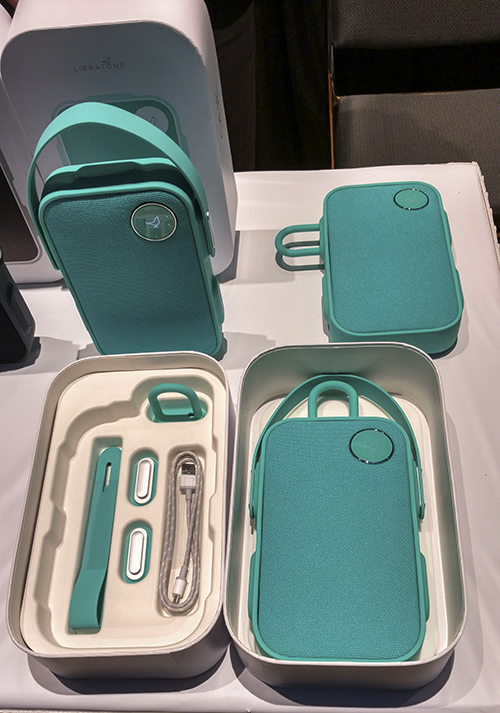Review: Moto Z Droid Smartphone
It feels like only yesterday when I purchased an unlocked Moto X Pure. Not even a year has passed from that date and we now see the latest offerings with the Moto Z moniker, this time from Lenovo. Within the Moto Z family, Verizon offers consumers the most choices: Moto Z Play Droid, Moto Z Droid, and Moto Z Force Droid. Lenovo didn’t stop there. They worked with third-party companies like Hasselblad and JBL to introduce complimentary products called Moto Mods. I had the pleasure of testing one such mod with a Moto Z Droid for a few weeks. How does the Moto Z Droid fare against its predecessor or the competition for that matter? Let’s find out in this Moto Z Droid review.
• Beautiful, creative design
• Solid construction
• Top of the line specifications
• Moto Mods accessories
• Quick battery charging time + TurboPower™
• Average battery life of 2600 mAh
• It’s water repellent, not waterproof
• No Moto Maker
• Some Moto Mods may be too expensive for some
• Wi-Fi drop issues
Moto Z Design and Features
As far as top-tier phones go, this model is very similar to those from Google, LG, and Samsung. All have top of the line specifications with regards to the screen, CPU, and GPU. When compared to its predecessor, the Moto X Pure, there are mostly design improvements, but a few back steps. The Moto Z is shorter in both height and width, and thinner in depth. The Moto Z is 0.91 mm thinner against the thinnest part of the Moto X Pure. If you recall, the latter has a curved back which consumers liked. The screen size has decreased from 5.7″ to 5.5″, which in my opinion is an improvement.
• Height: 153.9 mm
• Width: 76.2 mm
• Curve: 6.1 to 11.06 mm
• Weight 179 grams
• Height: 153.3 mm
• Width: 75.3 mm
• Depth: 5.19 mm
• Weight: 136 grams
Among reviewers, there’s been much discussion about the placement of the Moto Z’s power and volume buttons. For you left-handed users, this won’t matter one bit, but for you right-handed users, this is where a dispute arises. First of all, the change in location is a plus from where it was on the Moto X Pure. Even though the size of the buttons has decreased, many right-handed users won’t like how their thumb rests on the volume up button. I would have preferred to have the power button up high, rather be in the third position. Anyhow, all of this discussion disappears when you use a case to protect your phone.
Most, if not all reviewers, failed to view this button placement in the following way. I use a Joby mobile phone holder (and flexible tripod) with my Moto X Pure. This allows me to take better pictures and video of Elmas the cat and my skateboarding. Because you want to balance your phone, you would place the Joby holder along the centerline of your phone. You see, on the Moto X Pure, the volume buttons are in the way, hence the problem. With the Moto Z, there’s no button interference; thus one of my biggest headaches disappears as the Joby correctly grabs the phone.
Concerning the design, the aluminum chassis is too slippery in my hands. The removable back panel adds some texture, but it isn’t enough. If you want to ensure the Moto Z stays in your hand, a protective case is a must.
More Design and Features
The display on the Moto Z is a thing of beauty. Why this AMOLED screen didn’t appear on the Moto X is a mystery, especially when it appeared on its predecessor. I, for one, am glad it’s back. Like it’s predecessor, the display contains Corning® Gorilla® Glass. The only thing missing from this Droid is Shattershield™. If you want this feature, you’ll have to pay more as it’s only available on the Moto Z Force Droid.
Just below the AMOLED display, you’ll notice the fingerprint reader.
In case you haven’t heard or noticed, the 3.5 mm headphone jack and µ USB port were replaced with one USB-C connection. While I applaud this decision, I believe this change is premature and shouldn’t have taken place until the 2017 flagship model is released. You see, there are no headphones with a USB-C connection available just yet. To get around this issue, the folks at Lenovo include a 3.5 mm to USB-C port adapter with the Moto Z. Lose that dongle and you’re screwed, that is unless you have Bluetooth headphones. Charging and data transfer are done with this connection too.
[soliloquy id=”7068″]Speaking of charging, the battery size on the Moto Z is 2600 mAh. I believe this is one of those step backs I referred to earlier. If I were in the business of designing mobile phones, I wouldn’t have gone below 3000 mAh, which is what the Moto X Pure has.
If you desire more battery life, you have three options. You can upgrade to the Moto Z Force Droid which has a 3500 mAh battery, or you can purchase one of two mods: the Incipio offGRID™ power pack or the Mophie juice pack. These two mods will substantially provide extra battery life. They’ll also add weight and thickness to your device. The Incipio product has the added feature of being compatible with a wireless charging pad. It would have been nice for the Moto Z to charge wire free mod free. I believe this misstep should be corrected in the next design build.
Storage and memory have stepped up with the Moto Z. Like other flagship mobile phones, this one incorporates 4GB of LPDDR4 RAM. With storage, the phone is starting with either 32 or 64 GB on board with support up to 2 TB. Unfortunately finding micro SD cards over 256 GB is a laborious task.
Moto X Pure versus Moto Z Droid
• 1.8GHz Qualcomm® Snapdragon™ 808 processor with Hexa-core CPU and Adreno 418 GPU
• Android 6.0 OS
• 3GB LPDDR3 RAM
• 16GB/32GB/64GB, Micro SD Card support (up to 128 GB)
• 5.7” IPS TFT LCD, 1440p Quad HD (2560 x 1440), 520 ppi, Corning® Gorilla® Glass 3
• Battery (3000 mAh) TurboPower™ for up to 10 hours of power in 15 minutes of charging
• LTE Cat. 6 capable
• 21 MP Rear Camera ƒ/2.0 aperture Phase Detect Auto-Focus (PDAF)
• 5 MP Front Camera ƒ/2.0 aperture Wide-Angle lens
• Micro USB, 3.5 mm headset jack
• Moto Maker: 18 different inlays, colors, materials, and availability vary
• 2.2 GHz Qualcomm® Snapdragon™ 820 processor with Quad-core CPU and Adreno 530 GPU
• Android 7.0 OS and Google Daydream VR ready
• 4GB LPDDR4 RAM
• 32GB/64GB, Micro SD Card support (up to 2 TB)
• 5.5” AMOLED, 1440p Quad HD (2560 x 1440), 535 ppi, Corning® Gorilla® Glass
• Battery (2600 mAh) TurboPower™ for up to 8 hours of power in 15 minutes of charging
• LTE Cat. 9 capable
• 13 MP Rear Camera ƒ/1.8 aperture Optical Image Stabilization (OIS) Laser Autofocus
• 5 MP Front Camera ƒ/2.2 aperture Wide-Angle lens
• USB-C port for headphones, charging and data transfer
• No Moto Maker
Built-In Camera
Now onto my favorite feature. So much has changed with the built-in camera that I’m not sure where to begin.
If you didn’t notice from the list above, the camera size has decreased to 13 MP but the aperture has increased to ƒ/1.8. The truth of the matter is this isn’t all bad news. How many of you were taking images at 21 MP with the Moto X Pure? I certainly wasn’t and part of my job description is to take photos for a living. The increased aperture on the rear camera is a plus, while the decreased aperture on the 5 MP front camera is barely noticeable.
If capturing 21 MP image is a must, then you’ll have to upgrade to the Moto Z Force Droid. It’s your only option.
With the Moto Z, we now get laser autofocus and optical image stabilization, both of which are increasingly appearing on all higher-end phones. Digital zoom has increased from 4X to 8X. Also standard is Google Photo integration. In my opinion, none of these is even the best feature. That’s reserved for ‘Professional mode.’
[soliloquy id=”7065″]After activating the camera, in this case, the rear camera, touch the camera icon in the lower right corner of the screen. This action pulls up a menu consisting of the following: Photo, Video, Panorama, Slow motion, and Professional mode. The latter is most exciting. You can choose to take a photo right off the bat or you can open any of the five manual settings: Scene, White Balance, Timer, ISO (100-3200) and Exposure (-2 to +2). By adjusting any of the five settings, you can perfect your skills in the art of mobile photography.
On the main camera screen, there are icons for switching to the front camera, HDR (High Dynamic Range), Flash, and Timer. Swiping your finger to the left and right yield different results. When you initially swipe right, another menu appears. It’s in this menu where you can adjust such items as photo and video size, along with quick capture. Swiping left takes you to the images you just captured. No longer do you need to go into Photos (or Gallery) to see them. If you don’t like the picture the camera just captured, you can modify it or simply delete it. It’s a time saver for sure.
To take a screenshot, press and hold the power and volume down buttons for three seconds or until the camera shutter clicks, whichever come first. Sadly, I couldn’t get this to feature to function the way I believe it’s supposed to work. This a discussion I’ll need to have with my Verizon contact. I’ll update this post if the outcome changes.
Moto Mods
What makes the Moto Z family of phones stand out from its peers–a little something Moto Mods. Actually it’s a big deal. Roughly a year ago, LG introduced the G5, their flagship phone. After spending millions of dollars launching the product with commercials starring actor Jason Statham, sales have been a disaster. And the reviews weren’t much better. The biggest problem with LG’s design was that their phone was modular. Who wants to take apart a phone?
Lenovo took a different approach. They kept the phone intact, only allowing for the back shell to be removed. With this no-nonsense approach, Lenovo was able to reap those rewards that eluded LG. Lenovo has introduced a handful of mods, two of which have already been described above. The remaining ones are the JBL SoundBoost speaker, the Insta-Share projector, and the Hasselblad True Zoom camera. For the past few weeks, I had the pleasure of playing around with latter.
The Hasselblad True Zoom camera is quite the exciting product. With its 10x optical zoom, you’ll be able to take better, clearer photographs than before. After removing the back panel, the True Zoom mod magnetically snaps on and comes to life. With this mod, you’ll be to take photos at 12 MP and video in 1080P at 30fps.
Previously with the Moto X Pure, when you took a photo in HDR mode, you only received one JPEG image. Now, with the Hasselblad True Zoom camera mod on the Moto Z, you have the option to receive two images, JPEG and DNG, a RAW format. This added functionality comes in handy when you’re processing images in Adobe’s Photoshop.
The downside to having this mod is that it doubles the size and weight of the Moto Z. It’s a good thing that Lenovo provides a convenient carrying case for the Moto Z + True Zoom camera. It’s not only easy to carry around by hand, but it fits nicely into a back pocket or purse.
After spending $624 (or less) on the Moto Z Droid, purchasing the Hasselblad True Zoom camera mod for $299 (or less) is something you’ll have to ponder. My suggestion is to try out the camera mod at your local Verizon store, then decide.
Final Thoughts
Not only is the Moto Z Droid a worthy successor to the Moto X Pure, but it’s also a contender for your dollars against other top-tier mobile phones from the likes of Google, LG, and Samsung. Plus, no other brand has modular devices like Lenovo’s Moto Z.
While the Moto Z comes with some unnecessary bloatware, it’s easily removable. Oddly enough, the phone doesn’t come with Google Now Launcher pre-installed. Adding this should be one of the first things you do when you purchase the phone.
With CES2017 approaching, here’s hoping we see some new Moto Mods available in 2017.
What do you think of this Lenovo Moto Z Droid review? Do you agree or disagree with our verdict? Let us know in the comment section below or via social media. We’re eager to hear your thoughts.
The Moto Z Droid smartphone comes with a one-year limited end-user warranty. If you’re looking for the User Guide, it can be downloaded here. Don’t hesitate to head over to the Motorola website to see their latest Z family of phones.
FTC Disclosure: Verizon Wireless provided Beantown LLC with one (1) Moto Z Droid and Hasselblad True Zoom camera mod sample for review purposes. This writer’s opinion is 100% his own and not a paid product ambassador.
All photographs are the copyrighted property of Beantown LLC © 2016.











